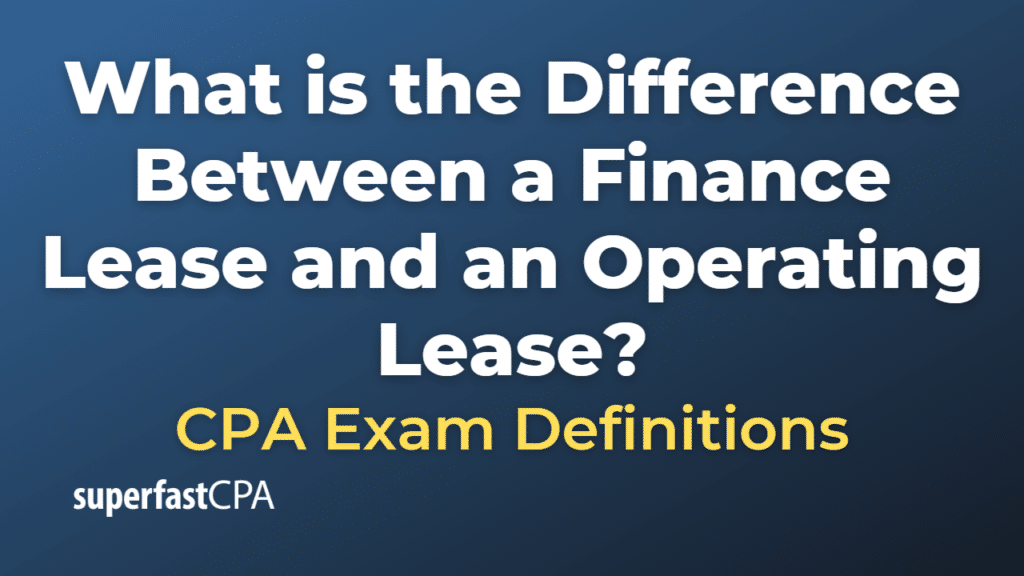Difference Between a Finance Lease and an Operating Lease
In business, companies often lease assets (like machinery, vehicles, or buildings) rather than buying them outright. There are two main types of leases: finance leases and operating leases. The differences between these two mainly have to do with the allocation of risk and benefits related to the leased asset, as well as the way they are accounted for.
Finance Lease (also known as Capital Lease)
A finance lease, also known as a capital lease, is a lease agreement in which the lessee (the one who rents the asset) assumes substantially all the risks and rewards of ownership. This kind of lease is generally long-term and non-cancelable, and it often includes a provision that allows the lessee to purchase the asset at the end of the lease term at a price below its expected fair market value.
From an accounting perspective, a finance lease is treated similarly to an asset purchase. The leased asset is recorded as a fixed asset (capitalized) on the lessee’s balance sheet, and the lease obligation is recorded as a liability. Over the lease term, the lessee recognizes depreciation expense for the asset and interest expense for the lease payments.
Operating Lease
An operating lease, on the other hand, is more like a rental agreement. The lessee uses the asset but doesn’t assume the risks and rewards of ownership. These leases are often shorter-term and may be cancelable.
From an accounting perspective, an operating lease does not result in an asset or a liability being recorded on the lessee’s balance sheet. Instead, the lease payments are treated as operating expenses and are recognized over the lease term on a straight-line basis (unless another systematic and rational basis is more representative of the time pattern in which use benefit from the leased asset is diminished).
Changes in Accounting Standards
In recent years, the accounting treatment for leases has changed, narrowing the difference between finance and operating leases. In 2016, the Financial Accounting Standards Board (FASB) issued a new accounting standard (ASC 842) that requires lessees to recognize a right-of-use asset and a lease liability on the balance sheet for almost all leases, including operating leases. This was a significant change, as it previously was not required for operating leases under US GAAP. The International Accounting Standards Board (IASB) has made similar changes (IFRS 16).
However, some differences still exist in the income statement presentation and the classification of cash flows for operating and finance leases.
The new standard went into effect for public companies for fiscal years beginning after December 15, 2018, and for private companies for fiscal years beginning after December 15, 2021.
Example of the Difference Between a Finance Lease and an Operating Lease
Let’s consider a business that needs a delivery van and a photocopier.
Operating Lease Example
The business decides to lease a photocopier, which has a relatively low value compared to their total assets and which will likely be upgraded in a few years as technology evolves. This lease agreement is set for 3 years, with regular monthly payments and no purchase option at the end of the lease.
Under the old accounting rules, this would typically be treated as an operating lease. The company wouldn’t need to report the photocopier as an asset or the lease obligations as a liability on their balance sheet. Instead, they would simply record the lease payments as an operating expense on the income statement over the term of the lease.
Under the new leasing standard (ASC 842), the company would still recognize the lease payments as an expense in their income statement but would also record a right-of-use asset and a lease liability on their balance sheet.
Finance Lease Example
Now, let’s say the business also decides to lease a delivery van, which is vital for their operations. The lease is for 5 years, and given the importance and value of the van, the lease agreement includes a provision that allows the company to buy the van at a below-market price at the end of the lease term.
This agreement transfers nearly all the risks and rewards of the van ownership to the business, so it would typically be treated as a finance lease. The business would record the van as an asset and the lease obligations as a liability on their balance sheet. Over the lease term, the business would also recognize depreciation expense for the van and interest expense on the lease payments.
The treatment would remain largely the same under both the old and new accounting standards, though there might be slight differences in the expense recognition pattern on the income statement.
This is a simplified example and the actual accounting can be more complex, depending on the specific terms and conditions of the lease agreements.













